

CULTURAL HISTORY OF MULTAN:
Multan, the cultural centre of southern Punjab famous for its sufi shrines, cotton and sohan halwa, is also a hub for the craft of blue pottery.From the ages, Indo-Pak subcontinent has been famous for its multi-dimensional cultural history. Multan, the traditional window to the heritage of Pakistan is a famous city for its artwork and craftsmanship and is living proof of our ancient ties with Turkish and Persian cultures. The origin of blue pottery dates back to the time of successful Muslim excursions into the Indus basin. The specialty of Multan that provides it fame all over the world is due to mesmerizing art of blue pottery. Blue pottery actually depicts the art in which blue ceramic designs are painted on the mud pots of various design by the skilled painters. Ceramic painting or blue pottery is an important cottage industry of Pakistan. The artwork is appreciated and purchased not only in Pakistan but it is also famous all over the world.
HISTORY OF BLUE POTTERY:
The skill for creating this blue pottery, also known as kashi work, was introduced centuries ago by local artisans, whose craft derived influences from Persia, Central Asia and the Mongols. It is widely believed that kashi works originates from Kashgar, a city in western China. But over a period of centuries, kashi work in Multan developed its own unique, indigenous style.
Blue pottery enjoyed patronage of the royalty and was used as utensils, decorative tiles and architecture. The mausoleum of Shah Rukne Alam and the shrines of Shah Ali Akbar and Shah Yousuf Gardezi that are located in Multan, all incorporate tiles exhibiting classic kashi work, conspicuous in blue pottery.
However, currently the craft, which has been an integral part of Multan’s rich heritage, is in decline due to the lack of patrons. Many workshops, which hitherto specialized in the creation of blue pottery, have abandoned production of handcrafted earthenware and instead use mechanization and artificial paints to create their utensils.
Yet some maestros of the craft, like Ustad Muhammad Alam, continue to preserve and promote blue pottery due to its historical and cultural significance for the City of Saints.Alam, who recently won the Pride of Performance award, has trained 500 students, including his six sons, in the last 50 years. Over the decades, Alam has bagged numerous awards lauding his superior craftsmanship, including awards from UNESCO India. He has also played host to countless dignitaries, ambassadors, delegations, and royals, who visit his workshop whenever they visit Multan.
Royal patronage, lucrative business and attraction of living monuments led many artisans and craftsmen to cement the name of Multan for its indigenous and marvellous designs of blue pottery work that reciprocates the Multan’s Artwork. In 1985, Punjab small industries corporation established an Institute of Blue Pottery Development to save the art from extinction. Blue pottery of Multan is at display in president’s house, prime ministers secretariat, culture missions of Pakistan in different countries and British Museum London.
Making of clay:
The clay which is used for making this pottery gets from Mansehra, Tharparkar, Gujrat and Pishawar. This pottery is hand crafted with the combination of red and white clay. This clay was getting from rivers and canals earlier but now due to the dirty water of the canals and rivers mountain clay is using to making the pots. White color is the base color and blue color show a cool effect of the hot weather of Multan. Now green, red, yellow and mustered colors are also used for making designs more attractive. Multani Blue Pottery has differentiation due to its combinational clay (white and red) while in other areas of the world this pottery is made with only white clay. Gas power furnaces are used to heat up these potteries on 1200 temperature and oxide colors are used for drawing designs. Due to heat they turned in actual colors from the black. There is a difference between “Kashi Kari “ and “Naqashi “ . “Naqashi” is done on leathers while “Kashi Kari is made on clay pottery. There are so many designs in Kashi named Angoor bail, Common Kashi , Full bhrai, T.D and many more. The artisans of Multan never use draw a design. They are skilled in designing directly with their own invented brush. These paint brushes are made through the squirrel’s tail. In Pakistan artisans and do not afford the imported paint brushes so they invented these brushes by their own. Now these brush are available on shops too in Pakistan . This Kashi Kari is not limited for ceramics, Home décor items also kashi work is done on tiles for the buildings and floors. Life of the tiles and pottery is 1000 years. This art is admired all over the world and have its own identity with the name of “Blue Pottery “. It has handed down from generation to generation.
Yet, the craftsman’s passion is certainly not enough to preserve the tradition of blue pottery in the city. This is obviously unsustainable in the long run, due to the products’ low monetary value and slack volume of sales. And unfortunately, it really seems that the craft of blue pottery, just like the dying craft of handmade art.
ORGANIZING THE WORKSHOP:
The workshop offered a course of making blue pottery that is a living tradition and almost on the verge of extinction now.The idea of workshop was to engage with the students of rural school is to realize its importance as well as its making process.The participants comprised an interesting mix. Three master artisans working under Potohar Organisation for Development Advocacy (PODA from Chakwal), who were also joined by the PODA Executive Director PODA Executive Director Sameena Nazir. The rest were teachers,and practioners.

The art form is a great activity to engage rural childrens.“The rural areas have no entertainment for children. Women in particular are not allowed to step outside their homes. Our master artisans will carry out workshops to teach and entertain the young ones about this craft.The students proudly displayed their finished products and received certificates from teachers. They discussed the plight of master artisans who form an ignored part of society and seem to have lost pride which in turn was affecting their work.
WORKSHOP THE MAKING AND PRESERVATION OF BLUE POTTERY:
This workshop offers the student for enthusiastic craft that interesting in learning the skills of producing traditional blue pottery earthenware.Inside the institute’s workshop, one encounters a riot of oceanic hues, floral designs and moulds. A plethora of clay pots, vases, lamps, cup and utensils furbished with wax are strewn inside the place. The painstaking stages of producing the beautiful pottery — starting from the arduous process of moulding the clay to baking it and then painting it – is accomplished by professional artisans, student trainees and teachers as well.While talking to the students about craft Handmade blue pottery needs attention from our people as well as from the government since it represents our national values and norms emphasized by instructors. Yet craftsmen passion is certainly not to preserved the tradition of blue pottery in the city,but it also obvious to financially support his institute or workshop.
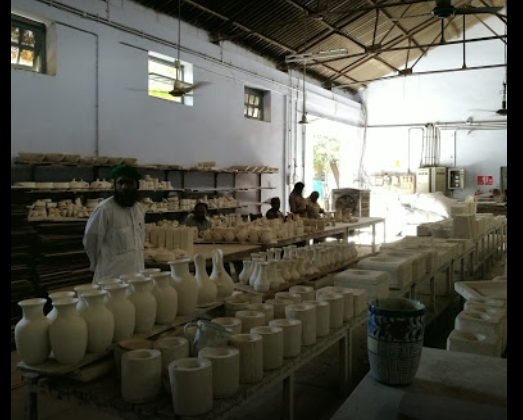
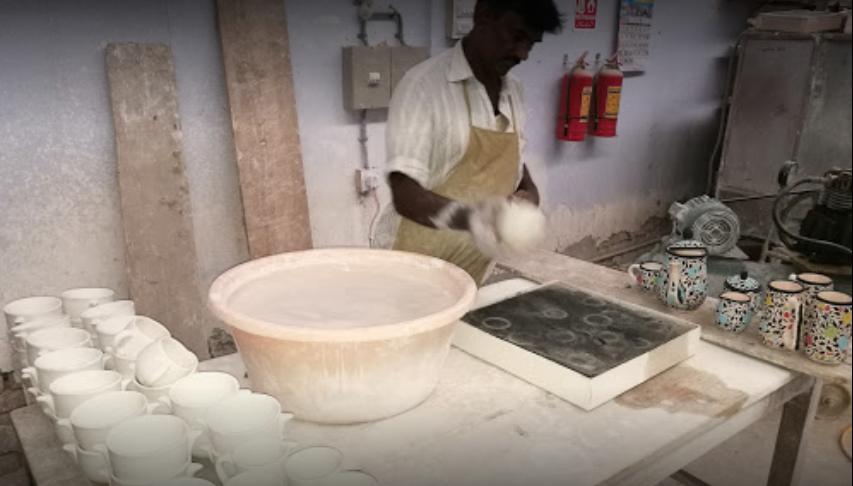
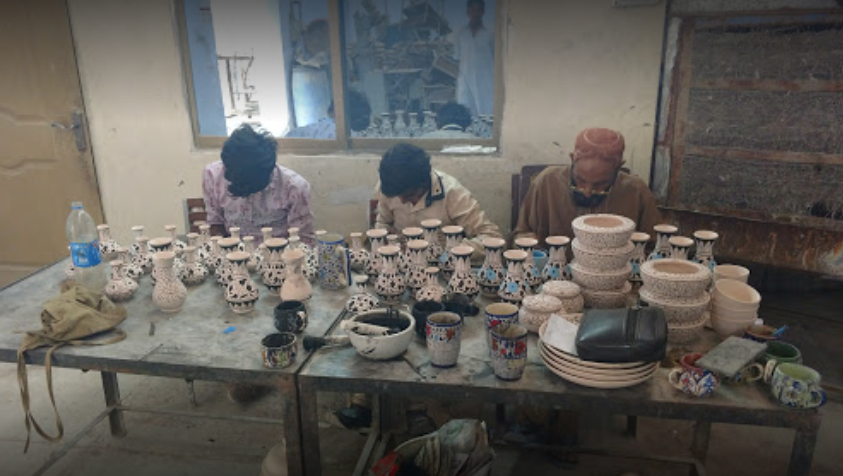
Materials required :
1: Pack of clay
2:Clay tools
3:Acrylic colours- Prussian blue, white, orange, golden yellow, and a waterproof black pen .
4:Brush no.- 2,3
5:Palette
6:Water bowl
7:A rough rag
8:Pencil
9:Eraser
Making of blue pottery.
The making process of blue pottery product is very tedious and time-consuming. It involves various stages. The whole process can be divided into following main steps;
1. Making of the Dough
2. Making of the Molds
3. Casting of the Products
4. Scrubbing
5. Finishing
6. Attaching the Base
7. Smoothening
8. Designing
9. Colour Making
10. Painting
11. Glazing
12. Firing
Making of the Dough
The raw materials like quartz powder, Multani Mitti, scrap glass, Katria Gond, and Saaji are used to make the dough for Blue Pottery. Firstly, Multani Mitti, scrap glass, Katria Gond, and Saaji are broken and ground into a fine powder. The mixture is kneaded properly to prepare non-sticky dough which is kept for at least 7-8 hours before using it.
Making of the Molds
Artisans develop molds in Plaster of Paris (POP) to caste the desired shape and size of the blue pottery products. The dough used in blue pottery lacks plasticity due to which they can’t be hard-pressed on wheel to make large products. The products break as the dough is pulled up. Therefore, the products are casted in to the molds. These molds are made in all desired shapes and sizes and then dried. One mold can be used for number of times if properly maintained. Small and easy product can be made in one mold, whereas complex items may involve more than one or two molds to make a final product. For example, a vase is made up in four parts. The central part is made out of two hemispherical molds while the neck and the base of the vase are turned on the potter’s wheel. All these four parts are joined together using the dough and the surface is smoothed.
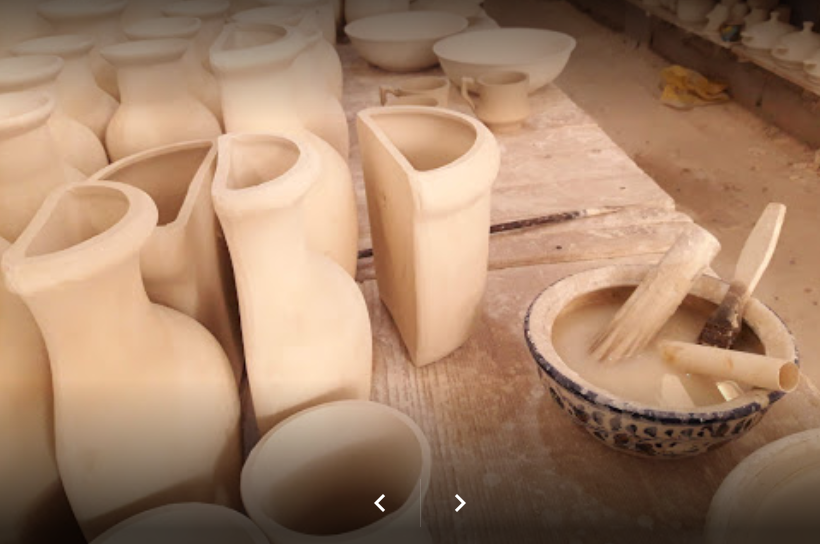
Casting of the Products:
For the casting of the products, the desired amount of the prepared dough is taken and rolled over the base stone. It is then flattened using a flattening tool on the stone base till is gets a round shape like chapatti with an approximate thickness of 4-5 mm. This round shaped chapatti is then carefully placed in the mould. The mould is continuously wiggled so that the dough sets properly inside the mold. Once the dough is partially placed in the mould, the mould is filled with raakh (burnt wooden dust) and is pressed gently so that the dough takes the exact shape of the mold. The extra edges of the dough which comes out of the mold are cut using a knife. After this the mold is turned upside down and removed, then the prepared product along with raakh is kept for 1-2 days for drying.

Scrubbing
After the product is dried and has taken the shape of the mould it is turned upside down and the raakh is removed from it. The extra raakh stuck on the walls are brushed off using a koochi (small broom). Generally while placing the dough in the mould the dough achieves an uneven thickness making the walls of the product non-uniformed. To create the walls of uniform thickness the product is sprinkled with a small amount of water to make it leather hard. After that, with the help of Patti (iron knife) the extra material is scooped off making the walls even. The product is dried again for a few hours through the day.
Finishing
The dried product now undergoes several stages of the finishing process, firstly the rough edges of the product are removed by rubbing it on the stone base. This process is done gently and carefully by hand. After that, the product is rubbed with regmaal (sandpaper) to remove the major grains, which occur due to raakh and scrubbing.
Attaching the Base
The products are added with a base wherever required. Generally, vases, small cups stand, etc. are provided with base to give them stability. The base is mainly fixed on the product (if round in shape) on the potter’s wheel. The product is turned upside down over the potter’s wheel and the base is sprinkled with water so that it gets leather hard. A small amount of dough is used along with some water to make the base. Once the base is made, the finished product is again left for drying for 1-2 days.
Smoothening:
The dried product with base now goes through another finishing process which is mainly focused on smoothing the surface for painting. Therefore products are coated with a coat of dough mixed with water to fill the major holes and dried. Once dried it is rubbed with regmaal (Sand paper) to smoothen the surface. The second round of coating is done once the product is rubbed. This time the product is dipped in the slurry, prepared by mixing quartz powder (10 kg), powdered glass (3 kg), Maida (edible flour, 2kg) and water. The process is done by hand in a way that the coating is done evenly. After drying the surface is again rubbed with regmaal and made ready for painting.

Designing
Once the surface smoothing process is completed the product moves to design development process. Artisan makes designs from his imagination and seldom uses a tracing. All products are individually painted by hand. Designing starts with making the outlines on a dried coated surface of the product. If the product is circular in shape it is placed on the potter’s wheel and the brush tip is touched on the surface while the wheel is rotating and thus the outline is made. The further intricate designs are made by hand using brushes of different sizes.
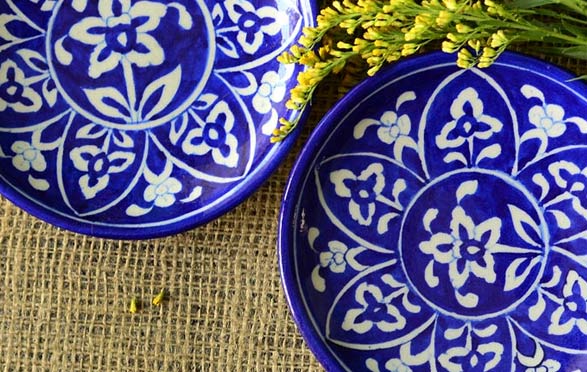
Color Making
The colours used in Blue Pottery are mainly oxides and sometime Ferro metal. These oxides are available in the market in the form of small lumps. The lumps of oxides are mixed with edible gum and made into powdered form by grinding. Edible gum acts as a binding agent.

Painting
The designs/outlines made on the products are now filled with oxide colours using fine brushes. The main colours used in Blue Pottery are blue, green, yellow and brown. The product is kept for drying once the painting process is completed.
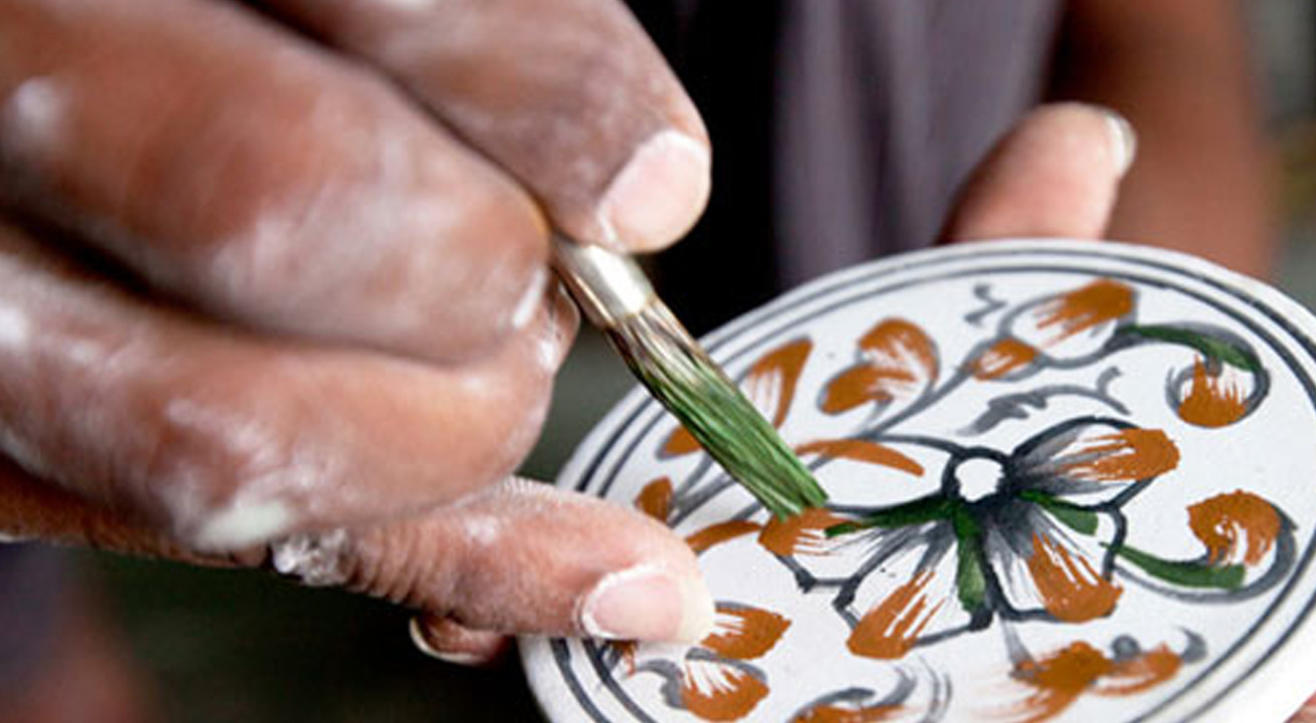
Glazing
After the paint is dried the product is glazed. A special glaze is prepared using different raw material in definite proportion. A mixture of powdered glass (21kg), Borex (17 kg), zinc oxide (1 kg) potassium nitrate (2 kg) and boric acid (7 kg) is prepared and heated till it melts. The mixture is allowed to cool and lumps are obtained which are again grounded into fine powder. This powder is further mixed with Maida(flour) and slurry is prepared using water. The final products are dipped in this solution in a way that it gets an even coating. The product is finally dried in sun.
Firing
The products prepared so far taken for firing in a closed kiln. They are stacked inside the kiln one on top of the other, separated by patiya and nali. The stacking is done with utmost care so that no two products stick to each other, there is proper circulation of heat within and the kiln is uniformly packed. If products stick to each other there are possibilities of them turning black. After stacking the kiln is closed from top. Heating is done from below using wood and charcoal. The temperature goes up to 800-850 degree Celsius. The firing process takes almost 4-5 hours. Thereafter, the kiln is left for slow cooling for 2-3 days. Any drastic change in temperature may lead to develop cracks in the products. Once the kiln is cooled, it is opened and the products are taken out and checked. In case of rejection, the pieces are separated. The final products are cleaned and are packed for the market.


Recommendation of books: Example 1
2: Handbook of the manufactures and arts of the Punjab by BH BADEN POWELL.
MAJOR OUTCOME AND CONCLUSION:
This one day workshop taught on different techniques on blue pottery and kashigari but the number of students were few,but they very curious and excited about the history and culture of Multan and its pottery. The institute workshop with the said objective to develop the traditional crafts of blue pottery and Kashigari. The references and books that were recommended to see were enthusiastic way of seeking knowledge about traditional craft of blue pottery.Basic discussions on marketing and the role of pottery on industrialized sector were discussed.By showing the process work and references of pottery children’s participated to create new innovative ideas that will developed childrens way of thinking .Experience of trainess had shown that something needed to be brought into the training workshops which would help spark the imagination so as to propel it forward. Contemporizing design which is one of the key aspects of the training requires a high level of involvement,and highly motivated participant.It was noted that methodology require some modification it would be best to perhaps to define thematic areas based on the immediate environment of participants.The workshop focused on how a pottery is developed and carried through a creative and floral design to produce beautiful better products.
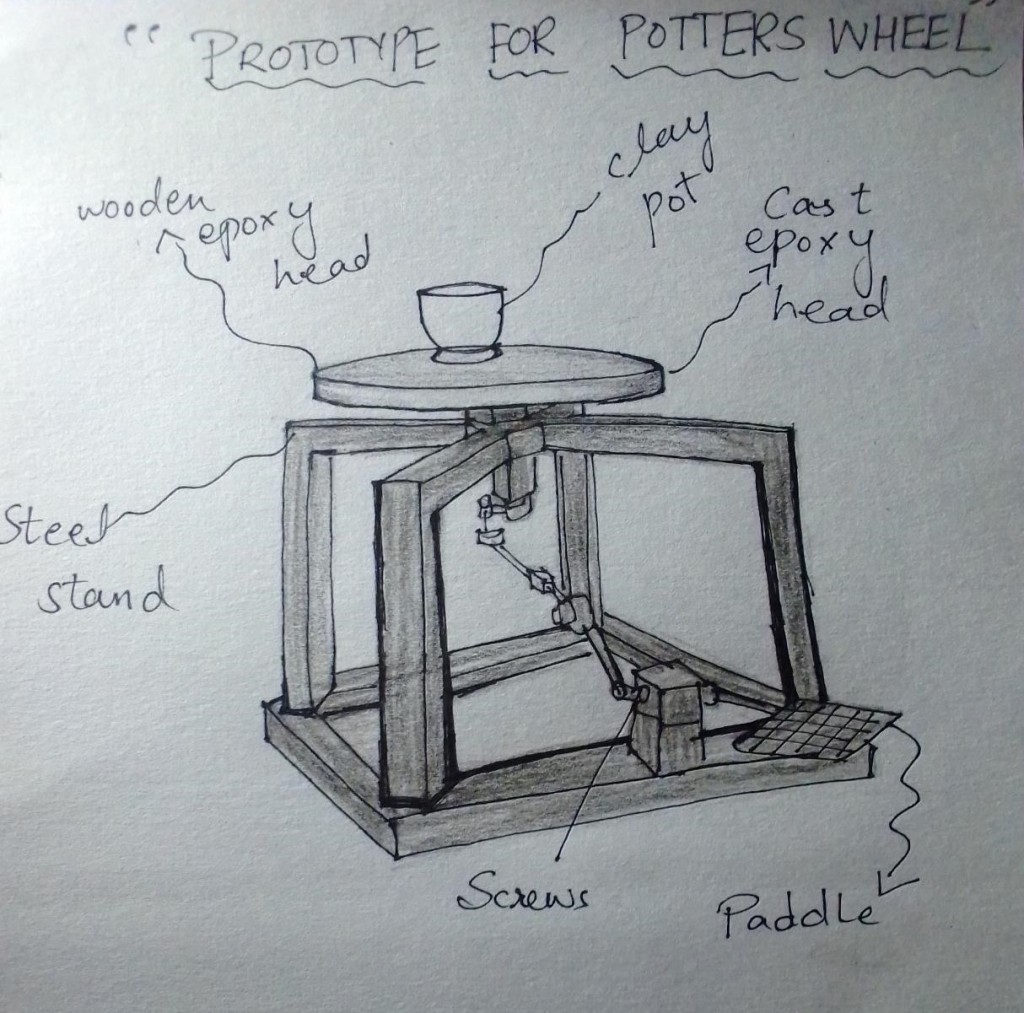
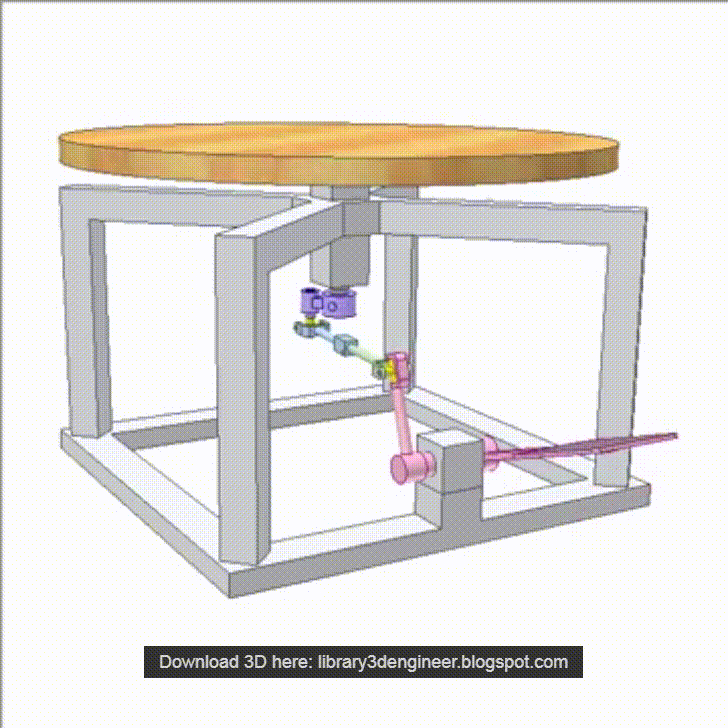
So i choose and make this update prototype of potter wheel for kumhar for making the process of pottery making .It works without the charging of any device.It consist of iron stand with screws and paddle holding wood epoxy head.So this prototype is for the labour who do not have any link with the pottery of industry as well as this is very suitable for the easiness of making of beautiful pottery.

